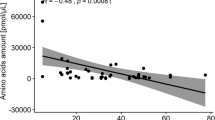Abstract
The increase of the amino acid concentration over different time intervals in artificial nectar (i.e., a sucrose solution) due to pollen contamination was investigated in four Californian plant species (Aesculus californica, Amsinckia lunaris, Brodiaea pulchella, Carduus pycnocephalus), which are important nectar resources for a Californian colony of the butterflyBattus philenor as well as for other insects. The increase of the amino acid concentration in the medium is different in all four species and seems to be determined by a variety of factors including permeability of the pollen grain wall and presence or absence of pores. The results suggest a passive diffusion process of the free pollen amino acids into the medium rather than an active release. Implications from the experiments forBattus philenor and for other nectar feeding pollinators are discussed. A possible complementary effect of free pollen and nectar amino acids is proposed for plant species in which pollen is likely to be knocked into nectar by their flower visitors. A possible evolutionary pathway from nectar feeding butterflies such asBattus philenor to the complex derived pollen feeding habit in theHeliconius butterflies is proposed.
Similar content being viewed by others
References
Baker, H. G., Baker, I., 1973a: Amino-acids in nectar and their evolutionary significance. — Nature241: 543–545.
—, —, 1973b: Some anthecological aspects of the evolution of nectar-producing flowers, particularly amino acid production in nectar. — InHeywood, V. H., (Ed.): Taxonomy and ecology, pp. 243–264. — London: Academic Press.
—, —, 1977: Intraspecific constancy of floral nectar amino acid complements. — Bot. Gaz.138: 183–191.
—, —, 1980: Studies of nectar-constitution and pollinator-plant coevolution. — InGilbert, L. E., Raven, P. H., (Eds.): Coevolution of animals and plants, 2nd edn., pp. 100–140. — Austin, London: University of Texas Press.
—, —, 1986: The occurrence and significance of amino acids in floral nectar. — Pl. Syst. Evol.151: 175–186.
Baker, I., Baker, H. G., 1982: Some chemical constituents of floral nectars ofErythrina in relation to pollinators and systematics. —Erythrina Symposium 4. — Allertonia3 (1): 25–37.
Barker, R. J., Lekner, Y., 1972: Free amino acids in thoraces of flown honey bees,Apis mellifera L., (Hymenoptera: Apidae). — Comp. Biochem. Physiol.43B: 163–169.
Boggs, C. L., 1987: Ecology of nectar and pollen feeding inLepidoptera. — InSlansky, F. Jr., Rodriguez, J. G., (Eds.): Nutritional ecology of insects, mites, spiders and related invertebrates, pp. 369–391. — New York: Wiley.
Bursell, E., 1963: Aspects of the metabolism of amino acids in the tsetse flyGlossina (Diptera). — J. Ins. Physiol.9: 439–452.
Buxbaum, F., 1927: Zur Frage des Eiweißgehaltes des Nektars (Vorläufige Mitteilung). — Planta4: 818–821.
Dunlap-Pianka, H., Boggs, C. L., Gilbert, L. E., 1977: Ovarian dynamics inHeliconiine butterflies: programmed scenescence versus eternal youth. — Science197: 487–490.
Gilbert, L. E., 1972: Pollen feeding and reproduction biology ofHeliconius butterflies. — Proc. Natl. Acad. Sci. U.S.A.69: 1403–1407.
—, 1980: Ecological consequences of a coevolved mutualism between butterflies and plants. — InGilbert, L. E., Raven, P. H., (Eds.): Coevolution of animals and plants, 2nd edn., pp. 210–240. — Austin, London: University of Texas Press.
Gottsberger, G., Schrauwen, J., Linskens, H. F., 1984: Amino acids and sugars in nectar, their putative evolutionary significance. — Pl. Syst. Evol.145: 55–77.
Jackson, J. F., Kamboj, R. K., 1986: Control of protein release from germinating pollen. — InMulcahy, D. L., Mulcahy, G. B., Ottaviano, E., (Eds.): Biotechnology and ecology of pollen, pp. 369–372. — New York, Berlin, Heidelberg, Tokyo: Springer.
Linskens, H. F., Schrauwen, J., 1969: The release of free amino acids from germinating pollen. — Acta Bot. Neerl.18: 605–614.
Murphy, D. D., Launer, A. E., Ehrlich, P. R., 1983: The role of adult feeding in egg production and population dynamics of the checkerspot butterflyEuphydryas editha. — Oecologia56: 257–263.
Sacktor, B., Childress, C. C., 1967: Metabolism of proline in insect flight muscle and its significance in stimulating the oxidation of pyruvate. — Arch. Biochem. Biophys.120: 583–588.
Scogin, R., 1986: Reproductive phytochemistry ofBombacaceae: floral anthocyanins and nectar constituents. — Aliso11: 377–385.
Sidhu, R. J. K., Malik, C. P., 1986: Metabolic role of boron in germinating pollen and growing pollen tubes. — InMulcahy, D. L., Mulcahy, G. B., Ottaviano, E., (Eds.): Biotechnology and ecology of pollen, pp. 373–378. — New York, Berlin, Heidelberg, Tokyo: Springer.
Stanley, R. G., Linskens, H. G., 1974: Pollen, biology, biochemistry, management. — Berlin, Heidelberg, New York: Springer.
de Vries, P. J., 1979: Pollen-feeding rainforestParides andBattus butterflies in Costa Rica. — Biotropica11: 237–238.
Willmer, P. G., 1980: The effects of insect visitors on nectar constituents in temperate plants. — Oecologia (Berlin)47: 270–277.
Yorks, P. F., 1979: Chemical constitution of nectar and pollen in relation to pollinator behaviour in a California ecosystem. — Ph. D. Thesis (Botany), University of California, Berkeley.
Author information
Authors and Affiliations
Rights and permissions
About this article
Cite this article
Erhardt, A., Baker, I. Pollen amino acids—an additional diet for a nectar feeding butterfly?. Pl Syst Evol 169, 111–121 (1990). https://doi.org/10.1007/BF00935989
Received:
Issue Date:
DOI: https://doi.org/10.1007/BF00935989




